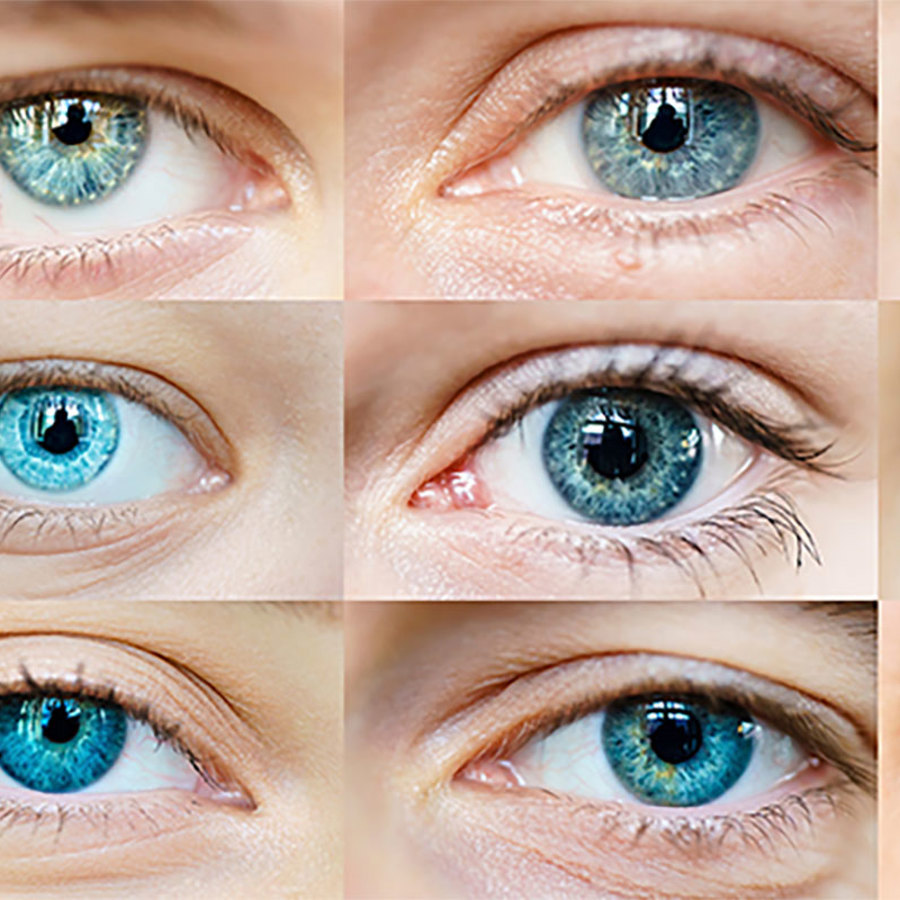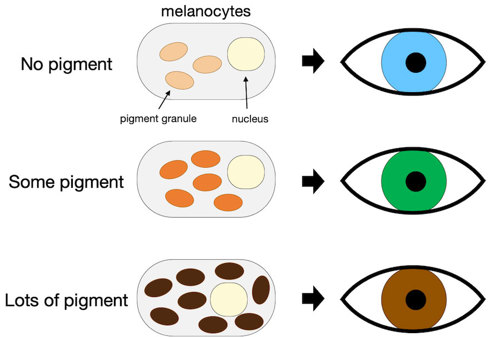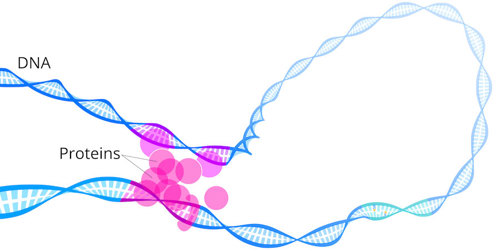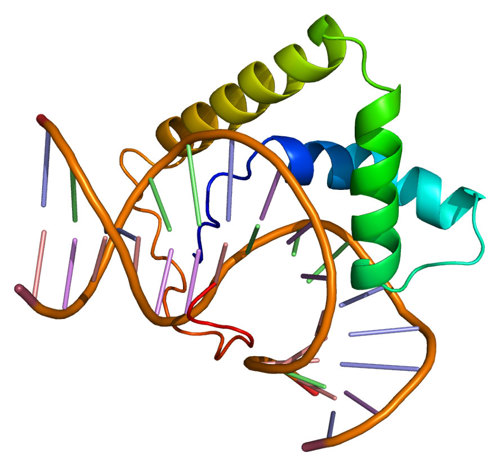
Do we know how the blue eye gene causes blue eyes?
August 14, 2013

- Related Topics:
- Eye color,
- Pigmentation traits,
- Gene expression
A curious adult from California asks:
We have known about the DNA difference (or SNP) that goes along with most cases of blue eyes for a while now. It goes by the name rs12913832 (which means it is reference SNP number 12913832) and is found in the HERC2 gene.
What we haven’t figured out is how this DNA difference, this single letter change, leads to blue eyes. HERC2 isn’t even involved in eye color and even if it were, this SNP isn’t even in what most people would consider the “meaty” part of the gene (the coding region).
But HERC2 is close to a gene that is important in eye color — OCA2. So one idea has been that the DNA difference in HERC2 somehow affects how the OCA2 gene works. The blue eye SNP is affecting OCA2 from a distance.
This is a pretty reasonable idea. Our DNA is littered with components of DNA that affect how distant genes work. These “enhancers” can make genes stronger or weaker or even turn them on or shut them off.
So the idea that the DNA difference in HERC2 that causes blue eyes does so by affecting the OCA2 gene from a distance is a good one. Unfortunately, there wasn’t a lot of evidence to support the idea. That all changed early in 2012.
This is when a study showed pretty convincingly that the piece of DNA in the HERC2 gene that we’ve been talking about can affect the OCA2 gene. In people with brown eyes, this piece of DNA turns the OCA2 gene way up while in people with blue eyes it doesn’t do much of anything at all. Blue-eyed people have a weak HERC2 enhancer and so have a lazy OCA2 gene.
This makes perfect sense considering how eye color works and what the OCA2 gene does. OCA2 is one of the genes responsible for making pigment in the body. The stronger the OCA2 gene, the more pigment you make, and eye color is determined by how much pigment you make in the eye. Little or no pigment gives blue eyes, some gives green and a whole lot gives brown.

So people with brown eyes have a hard working OCA2 gene that is pumping out lots of pigment in the iris of the eye. One reason it is so strong is because the HERC2 enhancer “coaxes” it to be that way.
People with blue eyes have an underachieving OCA2 gene. The DNA difference we’ve been talking about makes the HERC2 enhancer less able to affect the OCA2 gene. Less pigment leads to bluer eyes.
If this is all there was to the study, it would be impressive enough. But they actually took it one step farther. They were able to show that even though these two pieces of DNA are far apart, they do sometimes touch. And when they do, the OCA2 gene is turned up.
The two pieces of DNA touch each other more often in people with brown eyes as compared to people with blue eyes. So the blue eye SNP causes the HERC2 enhancer to touch the OCA2 gene less often. This leads to less pigment being made and so blue eyes.
For the rest of the answer, I thought I’d go into a little more detail on this last part. As you’ll see, the blue eye SNP actually affects how long the two pieces of DNA stay in contact. And this is what affects the OCA2 gene and ultimately giving blue eyes.

Magnets on a String
To understand how two faraway pieces of DNA can affect each other, let’s first think of an analogy. Think of the DNA as a string of flexible metal wire and the two pieces of DNA we are interested in as magnets on that string. These magnets only work when they are attached to the metal wire.
The magnets are far apart, so if we lay the string out on a table, they can’t affect each other. But if we start to shake, twist, and roll the table, the magnets sometimes get close enough to touch. When they do, they stick together.
But as an added complication, the magnets aren’t permanently stuck to the string. They sometimes fall off and have to be replaced. And when they fall off, they lose their magnetism and just roll away.
Believe it or not, this is pretty much how enhancers work. Our DNA is very much like a string in that it is very flexible. It has to be if we are going to fit six feet of it in each cell!
One difference is that the DNA isn’t really laid out on a table in a straight line. Instead it is precisely folded into an intricate wad. Other than meaning that some distant DNA is closer than we might think, the wire analogy still works.
The magnets in our analogy are proteins stuck to the DNA. And there aren’t just two.
Our DNA is clothed in a complicated and precise pattern of proteins that do all sorts of things. Some act like spools for the DNA to be wrapped around while others mark the start of genes. Some get genes to be turned up or down and still others shut genes down entirely. And this is just a very small part of what these proteins that sit on DNA do.
But for our story here, we’ll just focus on two. One of our magnets is actually a set of proteins bound to the OCA2 gene. Remember, this is the gene that makes pigment in the eye.
The other magnet is a set of proteins at the HERC2 enhancer. Remember, this is the bit of DNA that can make the OCA2 gene crank out extra pigment.

When each group of proteins manages to find the other, the OCA2 gene makes more pigment. This lasts as long as the magnet stays attached to the wire. Once it falls off, a new magnet has to be attached and then the two magnets have to find each other again. In blue-eyed people, these proteins find each other less well than in brown-eyed people.
What happens in real life is the DNA change that leads to blue eyes makes the proteins there stick less tightly. The proteins at the HERC2 enhancer come off more easily.
What this means is that the two pieces of DNA have the same chance of finding each other. It is just that blue-eyed people are less likely to have their proteins bound at the HERC2 enhancer. And even when they are bound, they don’t stay attached as long. Blue-eyed people have blue eyes because these proteins don’t touch as often. The “magnet” at HERC2 comes off easier if someone has blue eyes.
How does a one letter difference have such a significant effect? Well, the proteins I have been talking about like certain strings of DNA letters best. One might like TATAAAA and another GAATCC (remember DNA is made up of four letters: A, G, C, and T).
The proteins bound at HERC2 are no different. They like the letters found in brown-eyed people better than the ones in blue-eyed people. The one letter difference, a C instead of a T, causes the proteins to bind less well. Less binding leads to a weaker OCA2 gene, which leads to less pigment being made and results in blue eyes!

Author: Dr. D. Barry Starr
Barry served as The Tech Geneticist from 2002-2018. He founded Ask-a-Geneticist, answered thousands of questions submitted by people from all around the world, and oversaw and edited all articles published during his tenure. AAG is part of the Stanford at The Tech program, which brings Stanford scientists to The Tech to answer questions for this site, as well as to run science activities with visitors at The Tech Interactive in downtown San Jose.
 Skip Navigation
Skip Navigation
